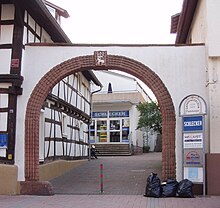Steamed noodle
Steamed noodles are a traditional pastry in southern German and Austrian cuisine. It is a variant of yeast dumpling preparation in which the yeast dough is fried and steamed in a saucepan with a lid at the same time, so that a crispy base and a soft surface are created. There are steamed noodles with and without filling, although the Palatinate variant is basically unfilled.
preparation
Steamed noodles are made from yeast dough. The dough , which in addition to milk , flour , yeast , salt , a little sugar and fat (e.g. butter ) sometimes also contains eggs , is formed into fist-sized balls after a reasonable amount of time. These are cooked in a closed pot that contains some milk and butter ( Bavarian recipe ) or salt water and fat ( Palatinate recipe ). In contrast to the similar yeast dumplings , which are cooked exclusively in boiling salted water or over steam, a golden brown crust develops where it touches the bottom of the pot (depending on the method of preparation, sweet or salty) after the added liquid (after approx. 15-25 minutes) is overcooked. Since the crust easily sticks to the bottom of the pot, a pot with a thick base and a particularly good non-stick coating or a classic heavy cast iron pan is usually used for cooking . To prevent the steam from escaping, the pot lid is usually weighted down.
variants
The steamed noodle can be served as a main course with cabbage , lettuce , cucumber or mushrooms in a cream sauce. As a dessert , the steamed noodle can also be consumed with warm or cold vanilla sauce , wine foam sauce or with compote.
In the Pfalz is the Dampfnudel a traditional main dish which either sweet supplements (for example, wine sauce , vanilla sauce or eingekochtem fruit as mirabelle , plums , pears or the like) or with saline supplements (for example, potato soup , stew or pigs pepper ) is eaten.
It is typical there to first serve a vegetable or potato soup with steamed noodles and then in the "second course" to eat the steamed noodles with a sweet sauce.
Steamed noodles are also found in Chinese cuisine . These are called baozi , made from yeast dough and steamed in baskets. They are usually filled with meat and vegetables. An unfilled variant is called mantou in northern China and is served as a side dish instead of rice or noodles.
origin
It is controversial whether their origins lie in the Bavarian or in the Palatinate cuisine . The Bavarian Ministry of Agriculture has included the steam noodle in an internet database in which Bavarian specialties are listed. This led to a letter of complaint from the Rhineland-Palatinate Agriculture Minister Hendrik Hering (SPD) to his Bavarian colleague Josef Miller (CSU). The Munich ministry assured, however, that steamed noodles are "guaranteed not" to be among the specialties that Bavaria wants to have EU-wide protected. In the Palatinate, steamed noodles are consumed with a salt crust.
Word origin
The word " noodle " is probably a modification of dumpling and thus part of a large stem of German words that express a thickening with the syllable sound kn- (knot, knuddel, tuber, bud, knob, button). Today one thinks of noodles especially on pasta . But the term encompasses much more.
Legends
There are so-called steam noodle gates in the Palatinate towns of Kandel (Palatinate) and Freckenfeld . The arches of these gates are each decorated with more than a thousand stone steamed noodles. The following legend has grown up around the Freckenfeld Dampfnudeltor: During the Thirty Years' War , a Swedish cavalry squadron demanded high money from the citizens, even though the Swedes, like the community citizens, were Lutherans at the time. Failure to do so threatened looting and murder. However, a delegation managed to moderate the Swedish captain's demand: he and his soldiers should be fed satisfactorily, then he would spare the population. Thereupon the master baker Johannes Muck had his wife and the maid cook a large kettle of sauce and ordered them to be seasoned with wine. He and his journeymen baked steamed noodles himself until every soldier was full: a total of 1,286 pieces. The squadron accepted the served dish with satisfaction and spared the village from further extortion or even destruction and murder.
See also
- Buchteln
- Yeast dumplings
- Mantou
- Yeast dumpling
- Baozi
- Dampfnudelblues , film adaptation of the novel of the same name by Rita Falk from 2013
literature
- Helga Rosemann: Steamed noodles. A Palatine-Bavarian specialty. Höma-Verlag, Offenbach 2012, ISBN 978-3-937329-65-9 .
Web links
Individual evidence
-
↑ Grain and Flour. Grain Research Working Group, 1951;
Angela Sendlinger: My big basic cookbook . Compact Verlag, 2009, ISBN 978-3-8174-6694-8 . - ↑ Eckhard Supp : Duden. Dictionary culinary arts. From amuse-bouche to decorative snow . Dudenverlag, Mannheim a. a. 2011, ISBN 978-3-411-70392-0 , Chapter: Regional dishes in German-speaking countries , p. 87 .
- ↑ Hot air around the steamed noodle. In: Stern. January 14, 2008.
- ↑ Rhineland-Palatinate and Bavaria quarrel over the steam noodle. In: Allgemeine Zeitung. (Mainz), January 15, 2008, p. 4.
- ↑ noodle. In: Jacob Grimm , Wilhelm Grimm (Hrsg.): German dictionary . tape 13 : N, O, P, Q - (VII). S. Hirzel, Leipzig 1889 ( woerterbuchnetz.de ).
- ↑ Elmar Seebold (arrangement): Kluge. Etymological dictionary of the German language. 25th, revised and expanded edition. De Gruyter, Berlin 2011. - Alternatively, it was also coming from grödnerisch menùdli , square Teigplätzchen in the soup ', from the Latin minutulus , crushed, tiny' proposed (ibid).
- ↑ Ortgemeinde Freckenfeld: History ( Memento of the original from March 15, 2012 in the Internet Archive ) Info: The archive link was inserted automatically and has not yet been checked. Please check the original and archive link according to the instructions and then remove this notice.






